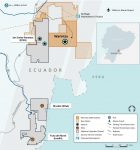
Uracan Resources is one of many junior uranium stocks that appear to be down and out. Or is it? In 2007, with uranium prices hitting record highs, Uracan Resources hit highs of over $1.60. Today, in the aftermath of the Japan crisis, the company’s shares are trading at a mere $0.07 valuing the company at $10 million. With net liquid assets north of $5 million (over half the companies market cap) the market is deeply discounting Uracan’s mineral properties which, according to the company’s most recent financial statements, have seen almost $30 million of past exploration and development expenditures.
Uracan is lead by well-know Vancouver mining venture capital professional Gregg Sedun. Mr. Sedun is a former corporate finance lawyer with 28 years of mining industry-related experience and now heads Global Vision Capital. Global Vision Capital develops mining projects and raises expansion capital for those projects from its network of institutional and professional retail investors. Collectively, Gregg Sedun and Global Vision Capital have raised over $1 billion in support of mining venture development; which may provide investors with some comfort that Uracan, although down, may not be out.
Gregg thanks for joining us, you’ve been involved in the mining venture capital markets for some time, please tell our readers a little about yourself and why did you get involved in uranium?
By way of background, I have had a 28-year career in mining, corporate finance and venture capital, of which about half was as a mining/finance lawyer and half running a venture capital firm I founded specializing in starting or financing early stage resource opportunities. My venture capital career started as a founding director of Diamond Fields Resources, which had a huge world-class nickel discovery called “Voisey’s Bay”. Diamond Fields was sold for $4.3 Billion in 1996 which allowed me to retire from law and start my own venture capital business. I am proud to say that this business has gone very well, as I have been involved in numerous companies as a founding shareholder and/or director that have resulted in significant shareholder gains.
In 2006, I became interested in uranium, based on a strongly increasing curve of the commodity price that was moving up from $25/lb., and eventually hit $140/lb., driving up valuations of uranium companies. I became aware of a very significant package of uranium properties that were previously owned by about 50 companies in the last big uranium play in Canada in the 1970’s and 1980’s. I partnered with Frank Giustra (one of the world’s great mining promoters) and Clive Johnson of Bema Gold fame to launch Uracan to buy 100% of all of the aforementioned properties, giving us a massive land position of over 1000 sq. km. We began exploring and immediately made a discovery in the Double S Zone, which we have expanded over the last 5 years to a significant NI 43-101 compliant resource. Unfortunately two unexpected events, the 2008 financial crisis and the 2011 Japan tsunami, seriously affected the junior uranium exploration and development sector, resulting in slowed growth for all uranium companies. That said, Uracan is excited about the future for uranium and we believe our patience and long-term business strategies will be rewarded in the coming years.
Obviously the earthquake in Japan deeply effected the uranium market. From a business management perspective, how did Uracan respond to the disaster?
Since Uracan is a uranium exploration company not currently in production, the earthquake in Japan did not dramatically affect our day-to-day business operations, other than causing us to modify our exploration program to reduce the company’s burn rate. However, the earthquake had repercussions on uranium demand which in turn affected uranium prices. This has resulted in dramatically lower valuations for all uranium related companies. The ability of these junior uranium companies to raise capital has therefore been hindered, causing a reduction in their exploration programs. We were no different than all of the other uranium juniors in this regard.
We would expect that as demand continues to rise for uranium and nuclear power, that this trend will reverse itself and Uracan will be in a strong position for future growth.
Where are your projects based and how are things progressing?
Uracan is in the business of exploring and developing bulk tonnage, near-surface uranium deposits at its two 100%-owned projects in Quebec and Saskatchewan, Canada. Our company’s focus is to develop these uranium deposits, which can be economically explored and mined, in order to maximize shareholder value. The Company’s flagship 1000 km2 project on the North Shore of Quebec hosts two main claim groups: Costebelle and Turgeon. We have been exploring in Quebec since 2006 and have been making steady progress toward our end goal. During that time, we have drilled approximately 346 holes and 65,800 meters.
At the Turgeon Claim Group, our project hosts a NI 43-101 compliant total Indicated Resource estimate of 21.5 million tonnes at an average grade of 0.014% U3O8 containing 3.11 million kilograms (6.86 million pounds) of U3O8 using a 0.010% cutoff at the Double S Zone. Within the Double S, Middle and TJ zones, the project hosts a combined total Inferred Resource estimate of 140.65 million tonnes at a weighted average grade of 0.012% U3O8 containing 16.826 million kilograms (37.095 million pounds) of uranium using a 0.010% cut-off. This project has year-round access, excellent infrastructure, and good open pit economics, which can be put into production relatively easily with low operating costs.
In the last two years, however, Uracan has concentrated its exploration efforts on the higher grade A4 and CC-11 Zones within the Costebelle Claim Group, which lies east of our Turgeon resource area. The grade at the Costebelle zones is approximately double that of the Turgeon zones. Costebelle has been the focus of Uracan’s drilling in 2010 and 2011, with the intention of establishing a new higher grade NI 43-101 compliant resource for this location. Summer mapping and sampling programs have identified numerous prospective zones within the Costebelle and Pontbriand claims that also require further investigation.
The Company’s intention is to continue evaluating the resource potential of these new and existing zones at the North Shore project in Quebec until we have established a large enough resource that we can advance into the next stage of development.
Uracan’s second property is a 100 sq. km project in Saskatchewan’s Wollaston domain, south of the Athabasca Basin. Our Pipewrench Lake property has had approximately 2600 meters drilled in 16 holes with encouraging results of up to 12.7 m at 0.142% U3O8.
Some people think this December could be an excellent time to revisit uranium stocks as investors look to lock-in tax losses. Is the sector finally ready for a rebound?
Yes, I believe the uranium sector is well poised for a rebound. In part, this resurgence began in mid-2010 when the price of uranium moved off its recent lows from the 2008 financial crisis and surged back into the mid $70/lb. range. This significant price momentum from $40/lb. to $70/lb. began to generate strong interest in the junior uranium sector once again. In March 2011, however, the world was hit with the unpredictable and tragic tsunami in Japan which sent the uranium sector back to the price levels of 2008.
One year later, the uranium sector is finally beginning to recover. The smart money, contrarian investors, are already buying high quality undervalued junior uranium stocks. To make money in this business, you need to be early and one step ahead of other investors and can’t always follow the trends. That being said, however, every investor has to allow a reasonable time frame for his or her investment to grow. In my view, patient investors who buy junior uranium stocks now at the heavily discounted price levels (or hold their current positions) and hang on for 1-2 years, will see a significant return on their investment.
Speaking on demand, where do think future demand for uranium will originate from and why?
It is no secret that future demand for uranium and nuclear power will be controlled through the developing socioeconomic transformation of Asia. As emerging world superpowers in support of nuclear power, China, India, Korea, and Russia will be the primary drivers of uranium demand over the next twenty years. Notably as well, we have recently seen expressed support of nuclear power from several G20 nations, including the United States, Britain and France. We expect Brazil to have a significant impact on demand as well. Brazil is emerging as an economic powerhouse and will require a substantial amount of energy to supplement its growth.
With a rapidly increasing global dependence on nuclear power, demand for uranium, which is the main energy source used in fueling nuclear power, is expected to soar in the next 5-10 years and we expect to see a significant increase in the uranium spot price. There are hundreds of nuclear reactors planned or proposed in the world today and given the world’s current levels of uranium production, this will result in a massive supply shortage of uranium.
Nuclear power is once again gaining global support as the only clean, affordable, reliable and GHG emission-free source of energy that can realistically supply the demand for energy worldwide. The world’s population is expected to reach 8 billion by 2030 and consequently, demand for clean energy sources will rise. Other renewable energy sources, such as wind, hydro and geothermal, cannot meet this global demand and thus, the world is gradually turning to nuclear power. Nuclear power is far more affordable than any non-renewable energy source such as coal, oil and natural gas. We expect this reliance on nuclear power to have a positive impact on uranium exploration companies, including Uracan.
The bottom line is that nuclear power is the most efficient, powerful and cleanest form of energy available. Nuclear power will likely play a major role in the growth and urbanization of this planet for decades to come. The demand for uranium will outstrip supply creating a substantial discrepancy for the amount of uranium available globally, resulting in significant upward momentum for uranium spot prices. Quality projects in stable countries, such as Canada, will benefit from this growth. In my view, Uracan is well positioned to capitalize on this opportunity.
This interview was featured in the article Uranium Stocks to Watch in 2012 – CLICK HERE to read more.




 Follow us on Twitter
Follow us on Twitter Become our facebook fan
Become our facebook fan











Comments are closed.